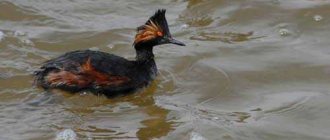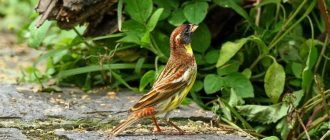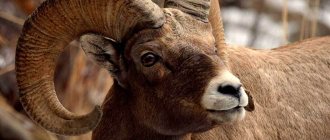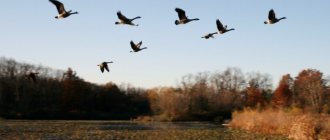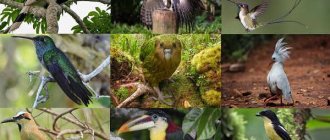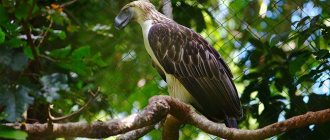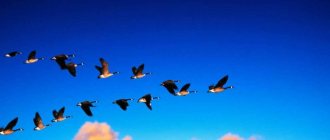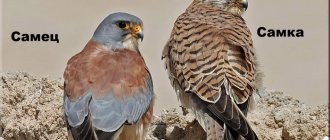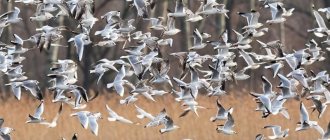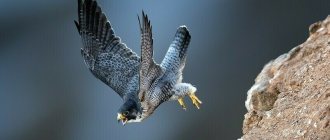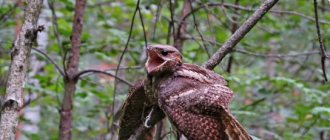The Central Russian region is characterized by a temperate continental climate. Winters here are not very frosty, and summers are warm and humid. The terrain is predominantly flat, only in some areas there are ridges and hills not exceeding 170 m above sea level. The region's vegetation is mainly represented by broad-leaved and mixed forests; a certain part of the territory is also occupied by meadows. All these factors influenced the rich species composition of the avifauna of central Russia. In total, there are at least 170 species of birds, some of which we will talk about in this article.
Great-footed owl
A small bird of the owl family. The length of its body usually does not exceed 27 cm. On its wide head there are small ears made of feathers. The owl's beak is short, sharp, curved down, and helps tear meat into pieces. The wings are long and wide, their span can reach up to 50 cm. The legs, like the entire body of the bird, are covered with thick feathers of a camouflage color. The owl lives in coniferous forests and tries to avoid open areas. It makes nests in tree hollows. It hunts at night, its prey being mice, shrews and other small animals.
Folk signs and migratory birds
A clear migratory schedule of birds has been noted since ancient times, therefore many folk signs are associated with birds’ arrival in their native lands. The onset of warm sunny days, the time of sowing cereals in the field and vegetable crops in the garden - observant people have associated the arrival of certain birds.
weather and migratory birds
Traditionally, the first birds to return from distant lands heralded spring and the arrival of warmth.
- Geese are calling for spring.
- Geese and ducks have returned not emaciated - expect a long and cold spring.
- A migratory bird moves in flocks - to a friendly spring.
- If you see a rook, notice spring.
- I saw a starling - spring is at the porch.
- The swallow has arrived - there will soon be thunder.
- The bird crows in bad weather.
- The larks have arrived - it's time to take out the hives.
- The finches have arrived - wait for the cold weather.
- A bird builds a nest in the sun - expect a cool summer.
- The jackdaws flew in and screamed for warmth.
- The nightingale is flooded all night - it will rain.
- The rook collects brushwood from the ground - it promises a sunny summer.
- Rooks are circling in a flock around the nesting site - it’s bad weather.
- The tit began to sing - to stay warm.
- The wagtail's legs are thin, but it will break the ice and bring spring.
- The larks began to sing early over the field - a warm spring is expected.
- Birds are in no hurry to fly south - it will be a warm autumn.
harvest and migratory birds
To this day, old people follow the tradition of sowing grains and other crops at certain times in the spring after migratory birds return home. And if you follow folk wisdom, you can grow an excellent harvest according to the bird's hint.
- The rooks have settled into the nest - in three weeks go out to sowing.
- The baby rooks are screaming - it's time to sow oats.
- The pied flycatcher calls for the start of plowing.
- The starlings have arrived - this buckwheat will arrive in 40 days.
- The chiffchaff began to crackle - these carrots and beets.
- The lapwings have arrived - prepare the turnip seeds for sowing.
- The oriole sang - it’s time to sow peas, cucumbers and cabbage.
- I heard the cuckoo singing on bare trees before Yegor (May 6) - don’t expect a harvest.
- The swift is circling en masse - it’s time to sow flax and barley.
- The cuckoo has crowed, the rowan tree has bloomed and the oak tree is opening - it’s time to sow flax.
- The birds returned from warmer climes on time - expect an excellent harvest of bread.
- The lark began to sing over the warm earth - it was time to sow grain.
Lapwing
A small bird of the Charadriidae family. The length of its body usually does not exceed 31 cm, the wingspan reaches 87 cm. The plumage is black and white, on the upper side of the body with a metallic greenish tint. There is a long crest on the head. Lapwing nests in open areas covered with grass. The eggs are laid in holes on the ground, with both parents involved in incubation. The bird feeds on insects and their larvae. Prefers to winter in southern countries.
Pastor
The starling's body is colored pink. Otherwise, the name of the birds in central Russia corresponds to the color black. The feathers on the tail, neck and head are colored with it. They have a purple glow. The bird has a crest on its head.
Its long feathers are located not only on top, but also on the sides of the muzzle. The legs of birds are reddish. In young starlings this is the only bright spot. In youth the birds are brown.
Pink starlings cannot imagine themselves without a team. The flocks of birds are so numerous that they cover the sky. They fly in tens of thousands. In the sky, the pale pink bodies of starlings are “lost.” The articles look like ink blots. Their density is caused by the habit of starlings huddling together in flight.
The pink starling nests in the desert steppes. In the absence of trees, birds dig holes in the soil, lining them with grasses and feathers. The density of the nests resembles the arrangement of starlings in flight. For 20 square meters - the same number of masonry.
Pastor
Ogar
A large waterfowl with bright orange-brown plumage. Belongs to the duck family. The length of its body often exceeds 60-65 cm, with a weight of up to 1.6 kg. The wingspan reaches almost 1.5 m. The ogre nests near bodies of water, some individuals settle in ponds within the city. It feeds on aquatic and terrestrial vegetation, insects, crayfish, mollusks, frogs and small fish.
What birds live in the garden
Many birds willingly settle around human habitation. In our gardens they have something to feast on: numerous larvae, harmful insects, worms, snails, slugs - and many more edible things can be found by the little feathered workers. The following birds live and nest in garden plots and nearby forests:
- wagtails
- goldfinches
- cuckoos
- warblers
- tits
- redstarts
- warblers
- sparrows and many other birds
Hoodie
A typical city bird of the corvid family. It is quite large in size, the body length is on average 50 cm, the wingspan reaches 1 m. The plumage is black-gray, with a brownish tint in young individuals. The crow feeds on plant and animal food and often forages for food in garbage containers. He is distinguished by his quick wit and ability to use various objects.
How to attract beneficial birds to the garden
To attract birds to the site, you should create comfortable living conditions for them. At the beginning of spring, titmice, nest boxes, and wooden houses for bird nesting are built on trees. It is advisable to plant dense shrubs in the form of a hedge along the perimeter of the site. In such places, small birds like to build their nests. And for the winter you should stock up on seeds, sunflower seeds, and nuts to feed wintering birds on frosty days.
Birds are faithful defenders of forests, park areas, our gardens and vegetable plots.
Little feathered friends delight us with their enchanting songs and attract us with the beautiful color of their plumage. The arrival of spring and the onset of warm days are heralded by the first birds that have flown to their native places from warm overseas lands. You should take care and treat with care the little singing creatures that bring peace and harmony to the planet. What birds benefit the garden and how to attract them, video:
Blackbird
A small songbird of the Thrush family. The length of its body reaches 26 cm, the wingspan is 35 cm. Males have black plumage, females and young individuals have grayish-brown plumage. The blackbird lives in coniferous, mixed and deciduous forests, and is often found in gardens and city parks. It leads a sedentary or nomadic lifestyle and does not fly away for the winter. It makes nests in a wide variety of places: from stumps and trees to flower pots on balconies. It feeds on worms, insects, berries and seeds.
Common nightingale
In central Russia, the bird appears on the 10th of May. If you follow the signs of nature, nightingales wait until the birch trees are covered with leaves. This means that the cold will not return until autumn and the water will not be covered with ice.
The proximity of water is the main condition for nightingales to nest. These songbirds in central Russia love moisture. Therefore, they look for vocal ones in floodplain and lowland forests.
Outwardly, by the way, nightingales are inconspicuous; their size is slightly larger than sparrows. The birds are brown-olive in color. The throat and belly are lighter than the main plumage. The upper tail feathers are slightly reddish. The “clothing” of females and males is the same. The mass is also the same. In adults it is equal to 25-30 grams.
Nightingales are classified as members of the thrush family. The common species is a relative of the western one. The latter is the most singing among the nightingales. Kinship has affected Russian birds. Their arias are almost as good as the songs of Western birds. Nightingales give concerts at night, fading at dawn.
In the photo there is a nightingale bird
Gray-cheeked grebe
A migratory bird of the grebe family with a wingspan of up to 85 cm and a body length of up to 50 cm. The summer color of the grey-cheeked grebe is bright and contrasting: the back and wings are blackish-brown, the front of the neck and chest on top are reddish-red, the belly is grayish-white, cheeks and chin ash gray. During the mating season, the upper part of the head is decorated with a black cap reaching to eye level. The winter outfit loses its brightness, at this time the plumage becomes grayish. The bird lives in the forest zone, making nests in ponds and in thickets of grass. The diet is based on invertebrates and fish.
What birds fly from the South in spring, photo with title
Birds are warm-blooded creatures, therefore, with the onset of cold weather, they are forced to leave their habitable places in search of comfortable places with a warm climate, so as not to freeze and die from hunger.
But as soon as spring comes, the birds return to their homeland and their usual life begins: setting up a nest, hatching eggs, feeding and raising babies. And all these troubles are accompanied by extraordinary life-affirming chants. Interesting fact: all migrating birds return to their old homes, following their internal schedule. Each species of migratory bird has its own flight time. Moreover, birds love old places of residence and nests in which chicks were previously hatched. If for some reason the home is destroyed, restless workers build new nests.
Wagtails and rooks are the first to arrive from warm countries, when the first thawed patches appear in the snow cover. Starlings , different types of ducks , larks return with the first warmth even when the ice has not yet melted.
Greenfinches and linnets also arrive from the south before the ice melts on the rivers. Birds with colorful plumage return from the countries of the northwestern part of the African continent, northern Iran and Central Asia, where they spend the winter.
The cuckoo is a prominent representative of migratory birds arriving in the summer from Africa and the Asian tropics.
Blackbirds spend their wintering grounds in the south. In early spring they gather in large flocks and return home.
Redstarts return from African countries and South Arabia, where they go for the winter at the end of August. Nightingales prefer to fly to hot Africa for the winter.
Gray crane
Omnivorous bird of the crane family. Its diet includes plant and animal foods, including acorns, leaves, berries, frogs, fish, snakes and even rodents. The crane grows up to 1.15 m in height, its wingspan reaches 2 m. The beak is long - up to 30 cm. The main background of the plumage is bluish-gray, there is a small red area on the head where there are almost no feathers. The gray crane makes nests in wetlands and migrates south for the winter.
What birds fly to Murmansk in spring
Murmansk is a city located beyond the Arctic Circle.
The location on the steep, rugged eastern cliffs of the Kola Bay and the temperate climate, moderated by the proximity of the Barents Sea, provide nesting opportunities for many unique birds. Dense forests and many lakes and streams also favor bird colonies. Ornithologists of the Lapland Nature Reserve are carefully studying the migration of birds for the winter and their return. From the beginning of April, the active movement of birds to the polar region begins.
The Bunting is a small beautiful bird with a snow-white chest and belly interspersed with black-brown feathers.
The sonorous trills of snow buntings can be heard from the beginning of April. Following the snow buntings, birds included in the Red Book of the Murmansk Region - whooper swans - , and in the last days of April - eagles . At the same time, the following birds are actively flocking to their former nesting sites: goldeneye , merganser , goose , mallard , gulls , and finches .
At the beginning of May,
the white-browed thrush and fieldfare .
Yellow wagtail
A small songbird of the wagtail family, growing up to 16 cm in length. She has a slender body and a long tail, which she constantly swings in different directions. The color of the plumage is dominated by grayish-green, brownish and yellow shades. The main habitat and nesting habitat of the yellow wagtail is moist, swampy meadows, river valleys and lowland areas of forests and forest-steppe. The bird usually flies to warmer regions to spend the winter. Feeds on small invertebrates.
What birds fly from warm countries in spring
Birds migrate to warm countries and, with the onset of winter conditions, are deprived of their usual food. These are all insectivorous birds: flycatchers , swallows , swifts , nightingales , warblers and other birds.
In winter conditions, these birds have no chance to survive, so flying to countries with a warm climate is an evolutionary reflex developed over a long time. Western Asia, the Mediterranean coast, the African continent are the places where birds go to wait out the winter. Migration of birds from warm places of temporary habitat occurs with the cessation of cold weather and the onset of spring. From the end of March to the first ten days of May, a massive return of birds from warm countries begins.
When flying away from their native nesting sites, migratory birds have to travel long distances and fly across seas and desert areas. New winter habitats for migratory birds must correspond to the usual temperature climate of their native places. Thus, forest birds settle in warm wooded areas, and coastal birds - on the coasts of rivers, lakes, sea and ocean islands.
We will show photos of migratory birds wintering in warm countries.
Lapwings arrive from southern countries in early spring.
They can be seen even in March during solar thaws. It happens that incoming cold weather, replacing short-term warming, forces lapwings to return to the nearest wintering grounds. Most often this is the Mediterranean coast. All species of blackbirds winter in warm countries. The most common species in Russia are: black thrush , song thrush , black-throated thrush , white-bellied thrush , Japanese thrush , brown thrush , etc.
White-browed thrushes are small birds from the thrush family that fly to the African continent for the winter in late autumn. They like to build nests in sparse birch forests.
Warblers are inconspicuous birds that can imitate the calls of other birds. They fly to India for the winter. The corncrake flies to Africa for the winter. A small secretive bird that lives in thick and tall grass.
Warblers are small songbirds. following species live in Russia: garden warbler , gray warbler , lesser warbler , and black-headed warbler . Birds feed on small insects, caterpillars, and larvae. When the berries ripen, they switch to the sweet menu. They spend the winter in African territories.
Warbler rattle
Photo: Alpo Roikola/Wikimedia Commons
A songbird of the warbler family, common in forests and parks. It grows no more than 13 cm in length, the wingspan can reach 24 cm. The color of the upper side of the body of the warbler is greenish, the abdomen and the area under the tail are white, the chest, throat and eyebrows are lemon yellow. The bird builds its nest from stems and leaves right on the ground, among thickets of bushes. It feeds on insects, spiders, mollusks and berries. Flies to Africa for the winter.
Which birds are the last to arrive to us?
The movement of birds to their native lands begins from the end of February to May.
Some birds feed on insects, larvae, worms, berries and fruits of plants that appear in late spring. Therefore, their arrival from distant countries occurs at a later time. Seagulls , geese , ducks , and cranes appear in their native places from mid to late April.
Warblers , tree pipits , and redstarts flock in early May. Warblers are miniature birds with a fragile build and a thin beak in yellow-green plumage. Insects are the favorite food of small birds.
Swifts , swallows , and nightingales return to their homeland in May. Swifts , like swallows, grab flying midges and insects in flight. Birds spend most of their lives in flight, taking beaks full of food and only then returning to the nest to feed their chicks.
Orioles and Golden Bee-eaters are beautiful birds with yellow plumage, the last to arrive from warm countries. The melodic singing of the common oriole is reminiscent of playing a flute, and is sometimes associated with the meowing of a cat. Midges, caterpillars, berries are delicious food for the tireless worker of the forests - the oriole.
The golden bee-eater is one of the most colorful and beautiful birds. Wild bees, wasps, bumblebees, dragonflies and other flying insects are the main food of the forest beauty, which swallows live food on the fly. Therefore, the bird moves early for the winter, and one of the last to return to its homeland when there is enough food for food.
Blue tit
An agile and dexterous representative of the tit family, growing up to 12 cm in length. The color of its plumage is dominated by blue and yellow shades; an azure-colored cap is clearly visible on its head; its cheeks and forehead are white. This species of tit lives in a variety of biotopes; the main condition when choosing a place is the presence of deciduous trees. Therefore, it can be found both in the forest and in the city park. As a rule, the blue tit leads a sedentary lifestyle; only the northern populations move to warmer places in the cold season. The main food of these tits is arachnids and insects.
What birds are useful for the garden?
Birds living in gardens are very beneficial for fruit and ornamental trees and shrubs. After all, small birds find harmful insects for food on our estates. It has been noticed that the birdies living in gardens do not allow the codling moth, pear bug, ringed silkworm, raspberry gall midge, aphids, caterpillars and other garden pests to breed. In addition, feathered friends delight us with extraordinary trills. We list the useful birds desired for our gardens:
- tits
- wagtails
- redstarts
- warblers
- robins
- lentils
These birds protect our garden from pests and do not damage the crop. But there are also birds that willingly eat not only worms in our gardens, but also sweet berries. This is how starlings are known to have a great desire to feast on ripe cherries. And the prankish sparrows peck at the sunflower seeds.
Pigeon
This is one of the most common representatives of the “feathered” fauna in the world. The pigeon can be found in any city, in any village and settlement. Its distinctive feature is its head that swings when walking.
There are 3 color types of this bird: white, black and gray-brown. Feather color is determined solely by genetic factors. Most pigeons settle in human habitats. The reason is the food that people kindly share with them. Because of this, they often unite in flocks to beg while surrounding people. Yes, the pigeon is one of the most voracious birds that can eat around the clock.
But not all representatives of this species were tamed. Wild pigeons avoid people, obtain food on their own and settle mainly in mountain gorges.
Despite their absent-minded appearance, pigeons have excellent spatial orientation. Even if you release an individual into the wild, it will definitely come back. Interesting fact! The pigeon is one of the few birds that can distinguish all the rainbow shades.
Magpie
Without a doubt, the magpie is one of the smartest birds in the world. Her intellectual abilities amaze and amaze. In the wild, this representative of the bird class expresses a wide range of emotions, from joy to despair.
Another amazing ability of the magpie is the ability to distinguish its reflection in the mirror from other objects. The magpie identifies itself as a bird when in any group.
When she senses danger, she makes a specific sound. It sounds a little like a grinding sound. This is done in order to attract the attention of other individuals who will fly to the rescue. Yes, the magpie is a flocking resident bird. But not only her brothers, but also other animals, including dogs and cats, react to the sound of a request for help.
Order: Falconiformes
Osprey - Pandion haliaetus
Common Honey Buzzard -
Pernus apivorus
Black Kite -
Milvus migrans
Hen Harrier -
Circus cyaneus
Steppe Harrier -
macrourus
Meadow Harrier -
Circus pygargus
Marsh Harrier -
Circus aeruginosus
Goshawk -
Accipiter gentilis
Sparrowhawk -
Accipiter nisus
Buteo lagop
Buzzard –
Buteo buteo
Snake Eagle -
Circaetus gallicus
Pygmy Eagle -
Hieraaetus pennatus
Greater Spotted Eagle -
Aquila elanga
Lesser Spotted Eagle -
Aquila
pomarina Aquila heliaca
Eagle -
Aquila chrysaetos
White-tailed Eagle -
Haliaeetus albicilla
Saker
Falcon -
Falco cherrug Falco peregrinus
-
Falco subbuteo
Merlin -
Falco columbarius
Red Falcon -
Falco vespertinus
Common Kestrel -
Falco tinnunculus
Waxwing
A specific feature of this bird is its mottled wings. Each of them has bright black and yellow stripes, as well as red circles reminiscent of rowan berries. The color of the resident waxwing bird is gray-brown. She, like the goldfinch, has a beautiful melodious voice, which is why some people keep her at home.
The size of a medium-sized individual is 20 cm. If you look closely at its head, you will notice a small crest on it. Sometimes, it heaves. This usually happens when the waxwing is scared or focused. Such birds settle mainly in the North. They are attracted to dense forests. You can often see waxwing settlements on the outskirts of forest clearings.
A peculiarity of this species is its preference to stay with other birds, gathering in large flocks. The waxwing's main food is insects. The bird flies very quickly, which allows it to easily catch small midges and satisfy its hunger. But it also feeds on the shoots of some plants and berries. In winter, the waxwing prefers to eat rowan.
Such a bird becomes sexually mature early, due to which its population increases every year. They make nests high in the trees. Waxwings are polygamous. This means that they change partners regularly.
The males of this bird species are very intelligent. During the mating season, they appease the female with gifts, for example, berries. If the gift is accepted, the male's need to reproduce will be satisfied. In the wild, the waxwing lives from 10 to 12 years.
Robin
The bird's closest relatives are nightingales. The robin is known for its ringing and melodious voice. These birds live in alder, spruce and forest parks. The food source is invertebrates; in warm weather they eat berries. A robin nests on the ground. Birds migrate to southern Europe singly. The birds return in April and immediately begin to build nests.
Owl
An owl is a sedentary bird that belongs to the class of predators. She hunts mainly at night. Scientists identify over 150 species of owls, each of which differs in size and color of plumage. But all these species are united by such factors as behavioral and hunting characteristics.
The “calling card” of this nocturnal predator is its large black eyes, thanks to which it easily tracks down its prey, even on a dark night. Their excellent hearing also helps them navigate in the dark. Even if the owl does not see the prey, it will definitely hear it.
The owl's main diet is small rodents, such as ground squirrels and chipmunks. But some individuals do not mind eating fresh fish. Scientists identify among them particularly ferocious individuals that even attack each other. In general, cannibalism in the wild is a fairly rare phenomenon.
Previously it was believed that owls form flocks, so-called parliaments. But then the statement was refuted, because, during visual observation, scientists established that the owl is a solitary hunter who contacts other individuals solely for the purpose of reproduction. Another distinctive feature of owls is their love of water. They drink quite a lot, especially in summer, but also swim in rivers and lakes.
Spruce crossbill
The list of intelligent songbirds is completed by the crossbill spruce. Its distinctive feature is its pronounced and large beak. In size, this representative of the feathered world resembles a sparrow, and in the color of its feathers, it resembles a woodpecker.
The crossbill is quite agile, fast and efficient. It feeds mainly on pine cones and wood bark. Thanks to its powerful beak, it easily splits even very durable surfaces. This bird almost never descends, preferring to perch on trees.
Its flight path is wavy and its speed is high. The period of crossbill activity occurs in the first half of the day. The bird moves very skillfully through the forest thanks to its beak and legs. Trying to split the cone, it clings to it and can hang there from several minutes to an hour.
The female crossbill is specific in that it can lay and incubate eggs even in winter. But for this, a condition must be met - the supply of food necessary for life. If, during the cold weather, the bird was unable to make reserves, it will not reproduce.
Crossbills have a crossed beak structure, which allows them to extract nuts from cones
Order: Charadriiformes - Charadriiformes
Tules - Pluvialis squatarola
Golden Plover -
Pluvialis apricaria
Ringed Plover -
Charadrius hiaticula
Little Plover -
Charadrius
dubius
Lapwing -
Vanellus vanellus
Avocet -
Recurvirostra avosetta
-
Haematopus ostralegus
Sandpiper -
Glareola pratincola Tringa ochropus
Fifi -
Tringa glareola
Greater snail -
Tringa nebularia
Grasshopper -
Tringa tetanus
Goldfinch -
Tringa erythropus
Sandpiper -
Tringa stagnatilis
Carrier -
Actilis hypoleucos
Mordunka -
Xenus cinereus
-
Arenaria interpres
Round-nosed Phalarope -
Phalaropus lobatus
Sandpiper -
Calidris minuta
White-tailed Sandpiper -
Calidris temminckii
Redshank -
Calidris ferruginea
Dunlin -
Calidris alpine
Gerbil -
Calidris alba
Mudbird -
Limicola falcinellus
Garcock -
Lymnocryptes minima
Snipe -
Gallinago gallinago
Great snipe - Gallinago media Woodcock - Scolopax rusticola Great Curlew -
Numenius
arquata
Middle
Curlew -
Numenius
phaeopus
Great Godwit -
Limosa limosa
Black-headed Gull -
Larus ichthyaetus
Lesser Gull -
Larus minutus Lakes
naya seagull -
Larus ridibundus
gull -
Larus fuscus
Herring gull -
Larus argentatus
-
Larus hyperboreus
Common
Larus canus
Kittiwake -
Rissa trydactyla
Chegrava -
Hydroprogne caspia
Black tern -
Chlidonias niger
White-winged tern -
Chlidonias leucopterus
White-cheeked tern -
Chlidonias hybridus
River tern Chick -
Sterna hirundo
Little Tern —
Sterna albifrons
Grouse
This is a resident bird popular among hunters. Despite its unimpressive size, hazel grouse are very easy to catch. It is often hunted with guns and dogs.
This bird can be distinguished from others by its specific coloring. Brown circles of different diameters are clearly visible on the white body. The hazel grouse's eyes are black, covered with a red rim. The average weight of a bird is ½ kg.
This representative of the fauna does not make long migrations, as it prefers to lead a sedentary lifestyle. He eats plant foods. But in winter it is more difficult to obtain such food, so the hazel grouse does not mind eating insects. By the way, its chicks also eat “live” food.
Jackdaw
Some people who encounter such a bird may think that it is a smaller version of a crow, or its chick. But, in fact, this is a separate species of birds - the jackdaw.
A distinctive feature of this bird is its black crown. The jackdaw is a small resident bird, 80% of whose feathers are black. It is worth noting that she is quite beautiful. Despite its dark, inconspicuous shade of feathers, the jackdaw stands out among other birds with its beautiful shape and neat tail.
This is one of the most sociable birds. Despite the herd instinct, the jackdaw gladly accompanies a large rook or thrush. She will walk next to him until she gets bored with him.
And they also have excellent memory. If you harm this bird once, it will remember it for the rest of its life. The jackdaw is an omnivorous bird. She enjoys eating berries, insects, plant food, etc. She doesn’t even disdain food waste and garbage. In urban areas, jackdaws are found only from early autumn to early winter.
